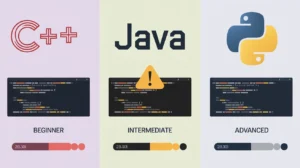In the ever-evolving world of programming, staying updated with the latest trends and languages is crucial for developers. Here is a comprehensive list of the top programming languages for 2024, highlighting their key features and benefits.
1. 🐍 Python
- Type: Object-oriented, interpreted, high-level language
- Usage: Web development, data science, automation, artificial intelligence, machine learning
- Key Feature: Dynamic semantics, extensive libraries, and frameworks
2. ☕ Java
- Type: Platform-independent, object-oriented language
- Usage: Enterprise applications, Android development, web applications
- Key Feature: Robust, secure, and portable
3. ➕➕ C++
- Type: Object-oriented extension to C
- Usage: Game development, system/software, drivers, client-server applications
- Key Feature: High performance, rich library support
4. 🅲 C
- Type: General-purpose procedural programming language
- Usage: System programming, embedded systems, OS development
- Key Feature: Low-level memory manipulation, efficient performance
5. 🌐 JavaScript
- Type: Interpreted language for the web
- Usage: Web development, server-side development (Node.js)
- Key Feature: Dynamic typing, prototypes, first-class functions
6. #️⃣ C#
- Type: Object-oriented, cross-platform language from Microsoft
- Usage: Windows applications, game development (Unity), enterprise software
Key Feature: Integrated with .NET framework, type-safety
7. 🗃️ SQL
- Type: Domain-specific language for database creation and manipulation
- Usage: Database management, data analysis
- Key Feature: Efficient data querying, manipulation capabilities
8. 🚀 Go
- Type: Statically-typed language by Google
- Usage: Backend systems, cloud services, serverless computing
- Key Feature: Simplicity, concurrency, garbage collection
9. 🛠️ TypeScript
- Type: Syntactic superset of JavaScript with static typing
- Usage: Large-scale web applications, frameworks like Angular
- Key Feature: Type safety, better tooling, and error handling
10. 🌐 HTML
- Type: Standard markup language for creating web pages
- Usage: Web development, document formatting
- Key Feature: Basic structure of web content
11. 📊 R
- Type: Programming language for statistical computing and graphics
- Usage: Data analysis, statistical modeling, scientific research
- Key Feature: Extensive statistical libraries and visualization tools
12. 🐚 Shell
- Type: Scripting language supported by Unix/Linux shells
- Usage: Automating tasks, scripting, system administration
- Key Feature: Command-line interface, powerful scripting capabilities
13. 💻 PHP
- Type: General-purpose scripting language
- Usage: Web development, server-side scripting
- Key Feature: Server-side execution, ease of use, integration with databases
14. 💎 Ruby
- Type: Interpreted, multi-paradigm language
- Usage: Web development (Rails), scripting
- Key Feature: Simplicity, productivity, developer-friendly syntax
15. 📊 SAS
- Type: Domain-specific language for statistical analysis
- Usage: Data analytics, business intelligence
- Key Feature: Powerful statistical analysis, data manipulation capabilities
16. 🕊️ Swift
- Type: General-purpose, multi-paradigm, compiled language by Apple
- Usage: iOS, macOS applications
- Key Feature: Safe, fast, expressive syntax
17. 🎯 Dart
- Type: Client-optimized language by Google
- Usage: Mobile, web, server applications (Flutter)
- Key Feature: Fast performance, reactive programming
18. 🦀 Rust
- Type: High-level language with focus on performance and safety
- Usage: System programming, web assembly
- Key Feature: Memory safety, concurrency
19. 🤖 Kotlin
- Type: Cross-platform, statically-typed language
- Usage: Android development, server-side applications
- Key Feature: Interoperable with Java, concise syntax
20. 📐 Matlab
- Type: Matrix-based language for computational mathematics
- Usage: Algorithm development, data analysis, numerical computation
- Key Feature: Extensive toolboxes, numerical computing power
21. 🔣 Scala
- Type: Strong statically-typed, multi-paradigm language
- Usage: Big data processing (Apache Spark), concurrent applications
- Key Feature: Functional and object-oriented programming
22. 🔧 Assembly
- Type: Low-level language that represents machine code instructions
- Usage: Embedded systems, performance-critical applications
- Key Feature: Direct hardware manipulation, high performance
23. 🧩 Perl
- Type: High-level, interpreted, dynamic language
- Usage: Text processing, system administration, web development
- Key Feature: Strong text manipulation capabilities, flexibility
24. 🖥️ Visual Basic
- Type: Event-driven, object-oriented language from Microsoft
- Usage: Windows applications, automation scripts
- Key Feature: Simple, easy-to-learn syntax, integration with Windows
25. 🍏 Objective-C
- Type: Object-oriented language adding Smalltalk-style messaging to C
- Usage: macOS, iOS applications (legacy)
- Key Feature: Dynamic runtime, object-oriented capabilities
Conclusion: Top Programming Languages for 2024
Each programming language has its own strengths and ideal use cases. Whether you’re developing web applications, engaging in data analysis, or building robust system software, choosing the right programming language can significantly impact the success and efficiency of your project. By staying informed about the top languages and their features, you can make informed decisions that align with your goals and industry standards.

















